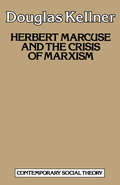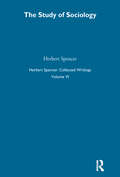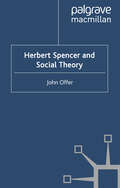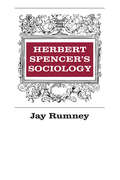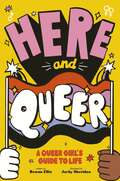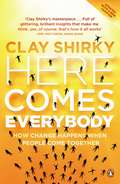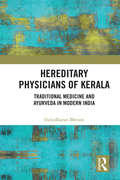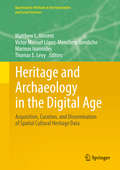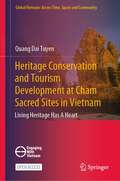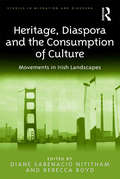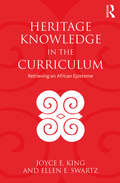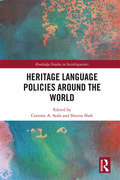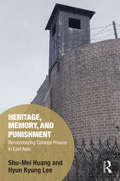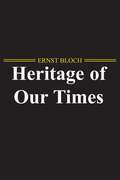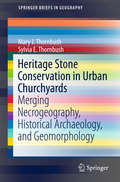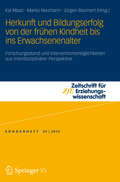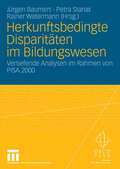- Table View
- List View
Herbert Spencer: Volume VI The Study of Sociology
by Herbert SpencerHerbert Spencer (1820-1903) was regarded by the Victorians as the foremost philosopher of the age, the prophet of evolution at a time when the idea had gripped the popular imagination. Until recently Spencer's posthumous reputation rested almost excusively on his social and political thought, which has itself frequently been subject to serious misrepresentation. But historians of ideas now recognise that an acquaintance with Spencer's thought is essential for the proper understanding of many aspects of Victorian intellectual life, and the present selection is designed to answer this need. It provides a cross-section of Spencer's works from his more popular and approachable essays to a number of the volumes of the Synthetic Philosophy itself. Volume VI The Study of Sociology.
Herbert Spencer: Volume VI The Study of Sociology (Works By And About Herbert Spencer Ser.)
by Herbert SpencerHerbert Spencer (1820-1903) was regarded by the Victorians as the foremost philosopher of the age, the prophet of evolution at a time when the idea had gripped the popular imagination. Until recently Spencer's posthumous reputation rested almost excusively on his social and political thought, which has itself frequently been subject to serious misrepresentation. But historians of ideas now recognise that an acquaintance with Spencer's thought is essential for the proper understanding of many aspects of Victorian intellectual life, and the present selection is designed to answer this need. It provides a cross-section of Spencer's works from his more popular and approachable essays to a number of the volumes of the Synthetic Philosophy itself. Volume VI The Study of Sociology.
Herbert Spencer and Social Theory
by J. OfferHerbert Spencer remains a significant but poorly understood figure in 19th century intellectual life. His ideas on evolution ranged across the natural sciences and philosophy, and he pioneered new ideas in psychology and sociology. This book comprehensively examines his work and strips away common misconceptions about his sociology.
Herbert Spencer's Sociology
by Jay RumneyThe republication of this book is eminently fitting at this time. Jay Rumney's Herbert Spencer's Sociology first appeared in 1937. In that year Talcott Parsons, citing Crane Brinton, declared: "Spencer is dead. But who killed him and how?" It was the thesis of Parsons' famous The Structure of Social Action that the evolution of scientific theory had put an end to Spencer. For more than a generation the man whose name had been synonymous with sociology was, or so it seemed, repressed and forgotten.
Herbert Spencer's Sociology
by Jay RumneyThe republication of this book is eminently fitting at this time. Jay Rumney's Herbert Spencer's Sociology first appeared in 1937. In that year Talcott Parsons, citing Crane Brinton, declared: "Spencer is dead. But who killed him and how?" It was the thesis of Parsons' famous The Structure of Social Action that the evolution of scientific theory had put an end to Spencer. For more than a generation the man whose name had been synonymous with sociology was, or so it seemed, repressed and forgotten.
Here And Queer
by Rowan EllisHere and Queer is a helpful, friendly guide full of support and advice about living your best queer life, written for girls. This vibrant, inclusive guide, designed for all kinds of girls, is designed to help you be the strongest, proudest, happiest version of yourself! A celebration of the gift of queerness, it's packed full of heartfelt advice, comforting stories and stylish illustrations, and will give you the tools you need to explore your own identity, on your own terms. Author and YouTuber Rowan Ellis uses her personal experience to take you through queer life, from coming out and dealing with tough stuff, right through to finding friendships and celebrating Pride. There are also brilliant guest essays from contributors across the LGBTQ+ spectrum. The book opens with guidance on understanding how you feel as a queer girl. From choosing your pronouns to navigating different labels and identities, Ellis helps girls understand that they are in control of their own identity, and that it's ok to not be sure straight away. Moving onto a glossary of queer terms, Here and Queer helps introduce girls to the rainbow of definitions and terms which help queer people understand who they are and how they feel. The book then moves onto advice on coming out, for many one of the hardest steps to take on their journey to truly living their best lives. Following are chapters on sex and romance, including helpful advice about your first time, as well as guides on consent and knowing how to make sure you build a healthy and supportive relationship with your partner. There are also sections on dealing with bullies and stigma, finding your community and looking after your mental health, including advice on how to help you find extra support if you need it. The book also has more information on queer ladies in history, and on the fight for equality undertaken by brave activists throughout history and today. Stylishly designed with cool illustrations, this friendly and supportive book will help all queer girls navigate the challenges of discovering and embracing their identities and flourishing in their own skins!
Here And Queer (PDF)
by Rowan EllisHere and Queer is a helpful, friendly guide full of support and advice about living your best queer life, written for girls. This vibrant, inclusive guide, designed for all kinds of girls, is designed to help you be the strongest, proudest, happiest version of yourself! A celebration of the gift of queerness, it's packed full of heartfelt advice, comforting stories and stylish illustrations, and will give you the tools you need to explore your own identity, on your own terms. Author and YouTuber Rowan Ellis uses her personal experience to take you through queer life, from coming out and dealing with tough stuff, right through to finding friendships and celebrating Pride. There are also brilliant guest essays from contributors across the LGBTQ+ spectrum. The book opens with guidance on understanding how you feel as a queer girl. From choosing your pronouns to navigating different labels and identities, Ellis helps girls understand that they are in control of their own identity, and that it's ok to not be sure straight away. Moving onto a glossary of queer terms, Here and Queer helps introduce girls to the rainbow of definitions and terms which help queer people understand who they are and how they feel. The book then moves onto advice on coming out, for many one of the hardest steps to take on their journey to truly living their best lives. Following are chapters on sex and romance, including helpful advice about your first time, as well as guides on consent and knowing how to make sure you build a healthy and supportive relationship with your partner. There are also sections on dealing with bullies and stigma, finding your community and looking after your mental health, including advice on how to help you find extra support if you need it. The book also has more information on queer ladies in history, and on the fight for equality undertaken by brave activists throughout history and today. Stylishly designed with cool illustrations, this friendly and supportive book will help all queer girls navigate the challenges of discovering and embracing their identities and flourishing in their own skins!
Here Comes Everybody: How Change Happens when People Come Together
by Clay ShirkyWelcome to the new future of involvement. Forming groups is easier than it's ever been: unpaid volunteers can build an encyclopaedia together in their spare time, mistreated customers can join forces to get their revenge on airlines and high street banks, and one man with a laptop can raise an army to help recover a stolen phone.The results of this new world of easy collaboration can be both good (young people defying an oppressive government with a guerrilla ice-cream eating protest) and bad (girls sharing advice for staying dangerously skinny) but it's here and, as Clay Shirky shows, it's affecting ... well, everybody. For the first time, we have the tools to make group action truly a reality. And they're going to change our whole world.
Hereditary Physicians of Kerala: Traditional Medicine and Ayurveda in Modern India
by Indudharan MenonThis book examines the history and evolution of Ayurveda and other indigenous medical traditions in juxtaposition with their encounter with colonial modernity. Through the lens of hereditary folk and Ayurvedic practitioners, it focuses on Kerala’s heterogeneous medical traditions and presents them against the backdrop of the geographical, historical, sociocultural, ethnographic and regional contexts in which they developed and transformed. The author explores the world of Kerala’s last traditionally trained hereditary practitioners (folk healers, poison therapists, Sanskrit-speaking Muslim Ayurvedic practitioners and the legendary Brahman Ashtavaidyan physicians). He discusses the views of these physicians regarding the marked difference between their personalised ancestral methods of treatment and the standardised version of Ayurveda compliant with biomedicine that is practised by doctors today. Drawing on extensive fieldwork, this book will be useful to researchers and scholars of medical anthropology, health and social medicine, sociology and social anthropology, the history of science and modern Indian history, as well as to medical practitioners interested in alternative and traditional medicine.
Hereditary Physicians of Kerala: Traditional Medicine and Ayurveda in Modern India
by Indudharan MenonThis book examines the history and evolution of Ayurveda and other indigenous medical traditions in juxtaposition with their encounter with colonial modernity. Through the lens of hereditary folk and Ayurvedic practitioners, it focuses on Kerala’s heterogeneous medical traditions and presents them against the backdrop of the geographical, historical, sociocultural, ethnographic and regional contexts in which they developed and transformed. The author explores the world of Kerala’s last traditionally trained hereditary practitioners (folk healers, poison therapists, Sanskrit-speaking Muslim Ayurvedic practitioners and the legendary Brahman Ashtavaidyan physicians). He discusses the views of these physicians regarding the marked difference between their personalised ancestral methods of treatment and the standardised version of Ayurveda compliant with biomedicine that is practised by doctors today. Drawing on extensive fieldwork, this book will be useful to researchers and scholars of medical anthropology, health and social medicine, sociology and social anthropology, the history of science and modern Indian history, as well as to medical practitioners interested in alternative and traditional medicine.
Heritage and Archaeology in the Digital Age: Acquisition, Curation, and Dissemination of Spatial Cultural Heritage Data (Quantitative Methods in the Humanities and Social Sciences)
by Matthew L. Vincent Víctor Manuel López-Menchero Bendicho Marinos Ioannides Thomas E. LevyThis book examines how computer-based programs can be used to acquire ‘big’ digital cultural heritage data, curate, and disseminate it over the Internet and in 3D visualization platforms with the ultimate goal of creating long-lasting “digital heritage repositories.’ The organization of the book reflects the essence of new technologies applied to cultural heritage and archaeology. Each of these stages bring their own challenges and considerations that need to be dealt with. The authors in each section present case studies and overviews of how each of these aspects might be dealt with. While technology is rapidly changing, the principles laid out in these chapters should serve as a guide for many years to come. The influence of the digital world on archaeology and cultural heritage will continue to shape these disciplines as advances in these technologies facilitate new lines of research. serif">The book is divided into three sections covering acquisition, curation, and dissemination (the major life cycles of cultural heritage data). Acquisition is one of the fundamental challenges for practitioners in heritage and archaeology, and the chapters in this section provide a template that highlights the principles for present and future work that will provide sustainable models for digital documentation. Following acquisition, the next section highlights how equally important curation is as the future of digital documentation depends on it. Preservation of digital data requires preservation that can guarantee a future for generations to come. The final section focuses on dissemination as it is what pushes the data beyond the shelves of storage and allows the public to experience the past through these new technologies, but also opens new lines of investigation by giving access to these data to researchers around the globe. Digital technology promises significant changes in how we approach social sciences, cultural heritage, and archaeology. However, researchers must consider not only the acquisition and curation, but also the dissemination of these data to their colleagues and the public.Throughout the book, many of the authors have highlighted the usefulness of Structure from Motion (SfM) work for cultural heritage documentation; others the utility and excitement of crowdsourcing as a ‘citizen scientist’ tool to engage not only trained students and researchers, but also the public in the cyber-archaeology endeavor. Both innovative tools facilitate the curation of digital cultural heritage and its dissemination. Together with all the chapters in this volume, the authors will help archaeologists, researchers interested in the digital humanities and scholars who focus on digital cultural heritage to assess where the field is and where it is going.
Heritage Conservation and Tourism Development at Cham Sacred Sites in Vietnam: Living Heritage Has A Heart (Global Vietnam: Across Time, Space and Community)
by Quang Dai TuyenThis open access book considers the growing field of heritage tourism from community perspectives. It explores how the Cham—Vietnam’s large ethnic minority—reconcile their needs for economic development with the boundaries circumscribed by their traditional culture. It examines struggles that local minority stakeholders like the Cham face when trying to participate in areas of development that typically fall under State control. How will tourism affect the ancient sacred spaces that are the Cham’s lifeblood? In what areas is their participation permitted? From what areas are they excluded? Through a novel mix of indigenous methods, participant observation, local voices, and rich ethnographic description, this book provides a rare glimpse into the discourses that have been percolating throughout the community in recent years. The relevance of this study extends beyond the Cham community, and aims to resonate with experiences of the myriad indigenous and minority communities around the world who face similar issues with heritage conservation and tourism development. This book is of interest to students and researchers of heritage studies, tourism management, cultural studies, Asian studies, as well as policymakers, and academicians seeking current research on the connections between culture, conservation, sustainable development, and tourism.
Heritage, Diaspora and the Consumption of Culture: Movements in Irish Landscapes (Studies in Migration and Diaspora)
by Diane Sabenacio Nititham Rebecca BoydUsing an interdisciplinary and transhistorical framework this book examines the cultural, material, and symbolic articulations of Irish migration relationships from the medieval period through to the contemporary post-Celtic Tiger era. With attention to people’s different uses of social space, relationships with and memories of the landscape, as well as their symbolic expressions of diasporic identity, Heritage, Diaspora and the Consumption of Culture examines the different forms of diaspora over time and contributes to contemporary debates on home, foreignness, globalization and consumption. By examining various movements of people into and out of Ireland, the book explores how expressions of cultural capital and symbolic power have changed over time in the Irish collective imagination, shedding light on the ways in which Ireland is represented and Irish culture consumed and materialized overseas. Arranged around the themes of home and location, identity and material culture, and global culture and consumption, this collection brings together the work of scholars from the UK, Ireland, Europe, the US and Canada, to explore the ways in which the processes of movement affect the people’s negotiation and contestation of concepts of identity, the local and the global. As such, it will appeal to scholars working in fields such as sociology, politics, cultural studies, history and archaeology, with interests in migration, gender studies, diasporic identities, heritage and material culture.
Heritage, Diaspora and the Consumption of Culture: Movements in Irish Landscapes (Studies in Migration and Diaspora)
by Diane Sabenacio Nititham Rebecca BoydUsing an interdisciplinary and transhistorical framework this book examines the cultural, material, and symbolic articulations of Irish migration relationships from the medieval period through to the contemporary post-Celtic Tiger era. With attention to people’s different uses of social space, relationships with and memories of the landscape, as well as their symbolic expressions of diasporic identity, Heritage, Diaspora and the Consumption of Culture examines the different forms of diaspora over time and contributes to contemporary debates on home, foreignness, globalization and consumption. By examining various movements of people into and out of Ireland, the book explores how expressions of cultural capital and symbolic power have changed over time in the Irish collective imagination, shedding light on the ways in which Ireland is represented and Irish culture consumed and materialized overseas. Arranged around the themes of home and location, identity and material culture, and global culture and consumption, this collection brings together the work of scholars from the UK, Ireland, Europe, the US and Canada, to explore the ways in which the processes of movement affect the people’s negotiation and contestation of concepts of identity, the local and the global. As such, it will appeal to scholars working in fields such as sociology, politics, cultural studies, history and archaeology, with interests in migration, gender studies, diasporic identities, heritage and material culture.
Heritage Knowledge in the Curriculum: Retrieving an African Episteme
by Joyce E. King Ellen E. SwartzMoving beyond the content integration approach of multicultural education, this text powerfully advocates for the importance of curriculum built upon authentic knowledge construction informed by the Black intellectual tradition and an African episteme. By retrieving, examining, and reconnecting the continuity of African Diasporan heritage with school knowledge, this volume aims to repair the rupture that has silenced this cultural memory in standard historiography in general and in PK-12 curriculum content and pedagogy in particular. This ethically informed curriculum approach not only allows students of African ancestry to understand where they fit in the world but also makes the accomplishments and teachings of our collective ancestors available for the benefit of all. King and Swartz provide readers with a process for making overt and explicit the values, actions, thoughts, and behaviors reflected in an African episteme that serves as the foundation for African Diasporan sociohistorical phenomenon/events. With such knowledge, teachers can conceptualize curriculum and shape instruction that locates people in all cultures as subjects with agency whose actions embody their ongoing cultural legacy.
Heritage Knowledge in the Curriculum: Retrieving an African Episteme
by Joyce E. King Ellen E. SwartzMoving beyond the content integration approach of multicultural education, this text powerfully advocates for the importance of curriculum built upon authentic knowledge construction informed by the Black intellectual tradition and an African episteme. By retrieving, examining, and reconnecting the continuity of African Diasporan heritage with school knowledge, this volume aims to repair the rupture that has silenced this cultural memory in standard historiography in general and in PK-12 curriculum content and pedagogy in particular. This ethically informed curriculum approach not only allows students of African ancestry to understand where they fit in the world but also makes the accomplishments and teachings of our collective ancestors available for the benefit of all. King and Swartz provide readers with a process for making overt and explicit the values, actions, thoughts, and behaviors reflected in an African episteme that serves as the foundation for African Diasporan sociohistorical phenomenon/events. With such knowledge, teachers can conceptualize curriculum and shape instruction that locates people in all cultures as subjects with agency whose actions embody their ongoing cultural legacy.
Heritage Language Policies around the World (Routledge Studies in Sociolinguistics)
by Corinne A. Seals Sheena ShahHeritage language policies define the context in which heritage languages are maintained or abandoned by communities, and this volume describes and analyzes international policy strategies, as well as the implications for the actual heritage language speakers. This volume brings together heritage language policy case studies from around the world, foregrounding globalization by covering five regions: the Americas, Europe, Africa, Asia, and Australasia. The countries profiled include the United States, Canada, Argentina, Norway, Sweden, Ireland, Uganda, Namibia, Morocco, Japan, South Korea, Singapore, New Zealand, Australia, and Fiji. This volume also highlights an expanded definition of ‘heritage language’, choosing to focus on individual and community identities, and therefore including both Indigenous and immigrant languages. Focusing specifically on language policy relating to heritage languages, the chapters address key questions such as Are heritage languages included or excluded from the national language policy discourse? What are the successes and shortcomings of efforts to establish heritage language policies? What is the definition of ‘heritage language’ in official usage by the local/regional government and stakeholders? How are these language policies perceived by the actual heritage language communities?
Heritage Language Policies around the World (Routledge Studies in Sociolinguistics)
by Corinne A. Seals Sheena ShahHeritage language policies define the context in which heritage languages are maintained or abandoned by communities, and this volume describes and analyzes international policy strategies, as well as the implications for the actual heritage language speakers. This volume brings together heritage language policy case studies from around the world, foregrounding globalization by covering five regions: the Americas, Europe, Africa, Asia, and Australasia. The countries profiled include the United States, Canada, Argentina, Norway, Sweden, Ireland, Uganda, Namibia, Morocco, Japan, South Korea, Singapore, New Zealand, Australia, and Fiji. This volume also highlights an expanded definition of ‘heritage language’, choosing to focus on individual and community identities, and therefore including both Indigenous and immigrant languages. Focusing specifically on language policy relating to heritage languages, the chapters address key questions such as Are heritage languages included or excluded from the national language policy discourse? What are the successes and shortcomings of efforts to establish heritage language policies? What is the definition of ‘heritage language’ in official usage by the local/regional government and stakeholders? How are these language policies perceived by the actual heritage language communities?
Heritage, Memory, and Punishment: Remembering Colonial Prisons in East Asia (Memory Studies: Global Constellations)
by Shu-Mei Huang Hyun-Kyung LeeBased on a transnational study of decommissioned, postcolonial prisons in Taiwan (Taipei and Chiayi), South Korea (Seoul), and China (Lushun), this book offers a critical reading of prisons as a particular colonial product, the current restoration of which as national heritage is closely related to the evolving conceptualization of punishment. Focusing on the colonial prisons built by the Japanese Empire in the first half of the twentieth century, it illuminates how punishment has been considered a subject of modernization, while the contemporary use of prisons as heritage tends to reduce the process of colonial modernity to oppression and atrocity – thus constituting a heritage of shame and death, which postcolonial societies blame upon the former colonizers. A study of how the remembering of punishment and imprisonment reflects the attempts of postcolonial cities to re-articulate an understanding of the present by correcting the past, Heritage, Memory, and Punishment examines how prisons were designed, built, partially demolished, preserved, and redeveloped across political regimes, demonstrating the ways in which the selective use of prisons as heritage, reframed through nationalism, leaves marks on urban contexts that remain long after the prisons themselves are decommissioned. As such, it will appeal to scholars of sociology, geography, the built environment, and heritage with interests in memory studies and dark tourism.
Heritage, Memory, and Punishment: Remembering Colonial Prisons in East Asia (Memory Studies: Global Constellations)
by Shu-Mei Huang Hyun-Kyung LeeBased on a transnational study of decommissioned, postcolonial prisons in Taiwan (Taipei and Chiayi), South Korea (Seoul), and China (Lushun), this book offers a critical reading of prisons as a particular colonial product, the current restoration of which as national heritage is closely related to the evolving conceptualization of punishment. Focusing on the colonial prisons built by the Japanese Empire in the first half of the twentieth century, it illuminates how punishment has been considered a subject of modernization, while the contemporary use of prisons as heritage tends to reduce the process of colonial modernity to oppression and atrocity – thus constituting a heritage of shame and death, which postcolonial societies blame upon the former colonizers. A study of how the remembering of punishment and imprisonment reflects the attempts of postcolonial cities to re-articulate an understanding of the present by correcting the past, Heritage, Memory, and Punishment examines how prisons were designed, built, partially demolished, preserved, and redeveloped across political regimes, demonstrating the ways in which the selective use of prisons as heritage, reframed through nationalism, leaves marks on urban contexts that remain long after the prisons themselves are decommissioned. As such, it will appeal to scholars of sociology, geography, the built environment, and heritage with interests in memory studies and dark tourism.
Heritage Of Our Times (PDF)
by Ernst. BlochHeritage of Our Times is a brilliant examination of modern culture and its legacy by one of the most important and deeply influential thinkers of the twentieth century. Bloch argues that the key elements of a genuine cultural tradition are not just to be found in the conveniently closed and neatly labelled ages of the past, but also in the open and experimental cultural process of our time. One of the most compelling aspects of this work is a contemporary analysis of the rise of Nazism. It probes its bogus roots in German history and mythology at the very moment when the ideologies of Blood and Soil and the Blond Beast were actually taking hold of the German people. The breadth and depth of Bloch′s vision, together with the rich diversity of his interest, ensure this work a place as one of the key books of the twentieth century.
Heritage Stone Conservation in Urban Churchyards: Merging Necrogeography, Historical Archaeology, and Geomorphology (SpringerBriefs in Geography)
by Mary J. Thornbush Sylvia E. ThornbushThis book provides a cross-disciplinary perspective on the degradation and deterioration of the cultural record encompassed by urban headstones located in parish churchyards. Its interdisciplinary approach allows the geomorphological analysis of rock weathering to be combined with the impacts on the cultural record, its interpretation, and management. In particular, by examining the impacts of air pollution on the weathering of these cultural markers, cross-temporal assessments can provide valuable information concerning the condition of the record and its sustainability potential as monuments of cultural heritage.Churchyards located in urban settings have grown in interest for the purposes of heritage conservation research. Specifically, headstones represent part of the historical and archaeological record and are recognised as a component of historical archaeology. They are also now approached from the standpoint of heritage conservation, either as monuments or cultural stone as well as being part of necrogeography through their address of burial and stone decay.In this brief, headstones located in parish churchyards in England and Scotland, as part of the Anglican record for the Church of England and the Presbyterian record for the Church of Scotland, were examined using non-destructive methods based on field observations since preliminary research in 2006 as part of a decadal scale (long-term) study. This multisite investigation captures the record since the 17th century, and mainly comprises limestone (England) and sandstone (Scotland) headstone markers that still remain upright. Most studied headstones appear before the 19th century, when this study’s temporal focus terminates. Seriations performed on the available record have revealed trends in style based on inscriptions, epitaphs, and motifs as well as quantified dimensions, shapes, and more. This study represents an attempt to pictorially record cultural stone and to observe cross-temporal and spatial change at various scales. As such, it offers a valuable resource for practitioners, e.g. conservators and archaeologists, as well as for students and researchers.
Herkunft und Bildungserfolg von der frühen Kindheit bis ins Erwachsenenalter: Forschungsstand und Interventionsmöglichkeiten aus interdisziplinärer Perspektive (Zeitschrift für Erziehungswissenschaft - Sonderheft #24)
by Kai Maaz Marko Neumann Jürgen BaumertDas Sonderheft der Zeitschrift für Erziehungswissenschaft gibt einen aktuellen Überblick über die vorliegenden Befunde zum Thema Ungleichheit in der Bildungsbiographie von der frühen Kindheit bis ins Erwachsenenalter. Darüber hinaus werden Interventions- und Fördermöglichkeiten zum Abbau herkunftsbedingter Bildungsungleichheiten aufgezeigt und vorliegende Befunde zur Wirksamkeit der verschiedenen Ansätze und Programme dargestellt. In besonderer Weise werden Beiträge und Sichtweisen der verschiedenen Forschungsdisziplinen - Soziologie, Psychologie, Erziehungswissenschaft und Ökonomie - in die Darstellung einbezogen und zusammengeführt.
Herkunftsbedingte Disparitäten im Bildungswesen: Vertiefende Analysen im Rahmen von PISA 2000
by Jürgen Baumert Petra Stanat Rainer WatermannErgebnisse der PISA-Studie haben gezeigt, dass der Zusammenhang zwischen schulischem Erfolg und Merkmalen der familiären Herkunft von Schülerinnen und Schülern in Deutschland besonders ausgeprägt ist. Diese herkunftsbedingten Disparitäten werden hier aus drei Perspektiven analysiert: neben der Grundlegung des methodischen Vorgehens wird der Einfluss der sozialen Herkunft auf den schulischen Erfolg untersucht. Welche Bedeutung haben individuelle und institutionelle Faktoren für die Entstehung von Disparitäten? Worauf sind Leistungsnachteile von Kindern und Jugendlichen mit Migrationshintergrund zurückzuführen? Welche Ansätze der Zweitsprachenförderung haben sich als erfolgreich erwiesen? Die Analysen geben Antworten.
